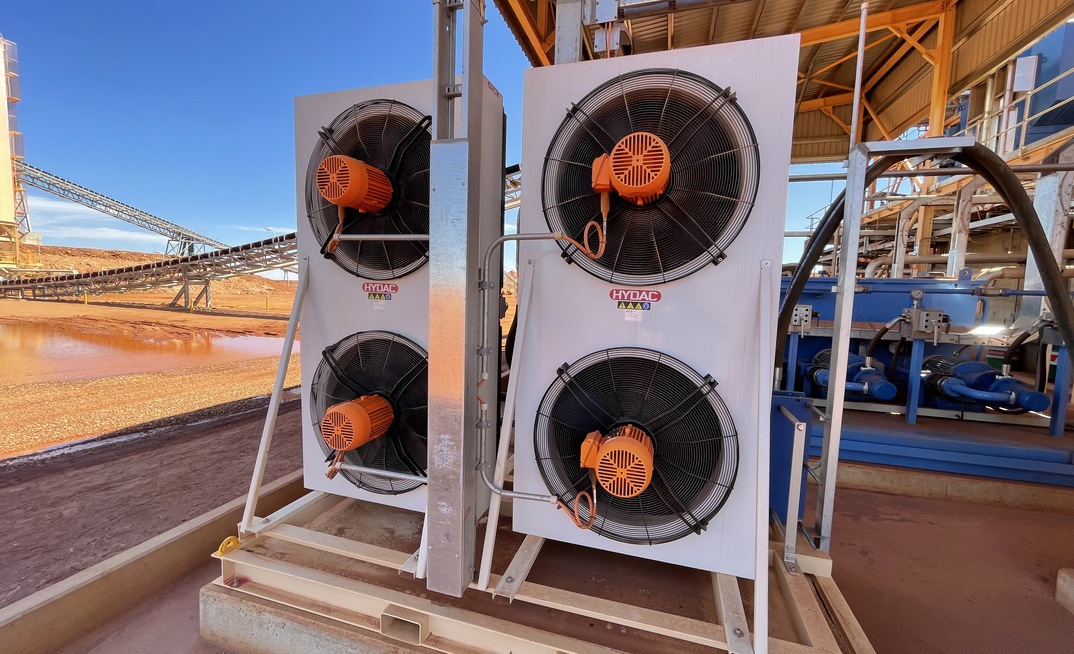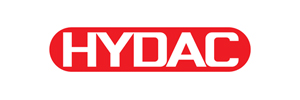HYDAC's hybrid system combines the best of two worlds, according to HYDAC National Development Manager for Cooling Systems Andrea Cimadoro.
"This is because we combine the optimal sizes of a gasket and plate heat exchanger coupled with that of an air blast cooler connected to a chiller. The combination of these components creates the word ‘hybrid'," he says.
"In layman's terms, our objective is to get the air blast cooler to be the strongest system in the room, able to drop from a given temperature to a temperature as close as possible to ambient because this constitutes a cheap, user friendly and environmentally friendly way to operate.
"And this constitutes unbeatable value at approximately $100 per kW."
He explains that HYDAC then couples the air blast cooler with a fluid barrier product such as a gasket or brazed plate heat exchanger and connects the other fluid to fluid side with a chiller.
"And it's here that the beauty and brilliance of the hybrid comes into play in that a massive chiller will not do the work because most of the work will be done by the air blast cooler."
In this case HYDAC puts forward a chiller that is not intended to run all year but only when needed and even then, in on/off mode, which translates into energy savings.
"For our purposes here, we'll merely describe the air blast cooler as a versatile hybrid system component that's easy to size with sizing software," Mr Cimadoro says.
The second main component of a hybrid system is a chiller, which is referred to as a RFCS refrigerant cooling system.
Cooling capacity is up to 300kWs and included in the deal is a control panel, integrated pump, and tank.
Presently HYDAC uses tap water or a water glycol fluid mix.
The chiller is more complex in that it has two circuits: the main driving circuit from the tank with recirculation through the system and a cool fluid side.
The chiller is referred to by HYDAC as the refrigerant side.
"The cold side of the chiller, or what is referred to as the refrigeration cycle, enables the fluid to be cooled below ambient temperature," Mr Cimadoro says.
The next component is the gasketed plate heat exchanger. This component is used for bigger contracts or when the fluid that must be cooled is "aggressive".
The gasketed heat plate exchanger is ideal for this because it can be cleaned, and the seals (gaskets) replaced.
The gasketed heat plate heat exchanger also comes with material such as titanium and stainless steel and the customer can select the gasketed or brazed plate heat exchanger.
The brazed plate heat exchanger is a stock item in Australia and therefore it's easily accessible. It has a double wall feature - just like the gasketed plate heat exchanger, that is advantageous when it's undesirable to mix two fluids in a system
Advantages of the hybrid system
One of the biggest advantages of the hybrid system is the capacity it provides for one component - the air blast cooler - to move from a given temperature of 70°C, 80°C or 90°C to whatever temperature is closest to ambient temperature as required by an application.
This is of course dependent on how it is sized and whether it comes with variable speed drive technology.
This is the best option available in terms of kilowatt versus dollar value and low power consumption.
The chiller is more precise because fluid temperature can be easily controlled in a confined space.
This is because temperature fluctuation is an issue in the law of application up to about 1°C or 0.5°C. This means the temperature of the hybrid system's chiller must be near the application being cooled.
"Therefore, the chiller's tasks include temperature drops below ambient and accurate temperature control. And it is for these reasons that chillers are part of the hybrid team because some applications require this function. And yes, it's a more sophisticated technology and therefore kilowatt per dollar is more expensive at about $1000 per kW," Mr Cimadoro points out.
"But that's the beauty of the hybrid - chiller sizing takes place according to requirement without oversizing taking place and usage takes place when required. And as we well know. running on and off at specific times translates into substantial power savings.
"If, however, a cooling problem is tackled with only a huge chiller it's going to be heavy going and expensive as it will run the majority of the time whereas the HYDAC hybrid way comes in at half the price of a standard chiller."
To go more in-depth, auto function is a feature on the air blast cooler and compressor cycling on the chiller, with air blast open to control via tight variable speed drive.
Power on the air blast cooler and chiller also only takes place when required.
From an eco-friendliness point of view, it is undeniable that the system is built on high-quality components.
It is also possible to reduce refrigerant volume in use if a small chiller instead of a big one is used, and use of the water chiller and water glycol only occurs when required.
"From a process point of view the system can never back up in a high load situation because there is more than one component at hand," Mr Cimadoro says.
"Just imagine you have a data centre, and your main chiller goes awry - well that would be a disaster. Now imagine a data centre with a hybrid cooling system: even if the air blast or the cooler failed, there is enough redundancy in the system to take over and keep the temperature stable. It's clear to see that not having stable temperature in a data centre could make for sleepless nights.
"However, when control is maintained, and the system is kept at the right temperature in every circumstance longevity of lifetime is achieved. In fact, every day and in every hour of the machine's lifetime we indirectly extend its lifetime and promote long-term reliability and service life."
HYDAC also applies smart control from its electronics division.
System availability
HYDAC excels in systems availability.
"The hybrid system is effectively made up of the best of three worlds as well as something that HYDAC installs - system availability. And yes, you can have a system with only a big chiller and gasket without air blast, but it will come at double the cost. Alternatively, a simple system with only an air blast will be cheaper but will come without the same cooling capacity," Mr Cimadoro points out.
"So again, I don't think there is any system that is more cost effective and efficient than a hybrid cooling system that combines two or three worlds, or more if additional cooling devices are attached.
Real application that delivers the goods
Western Australia mining site
In this instance HYDAC used a containerised chiller because of the gold mine's harsh, dusty and at times wet environment in Western Australia.
"In this application we containerised the chiller to give it a long lifetime and connected it with a brazed plate heat exchanger. The brazed plate heat exchanger is connected to two of HYDAC's size 14 air blast coolers," Mr Cimadoro says.
"This is an interesting system as it cools the main crusher's oil lubrication system when a temperature below ambient is required. This is only required for some portions of the year, with the air blast doing its job for the remainder of the time."
Mr Cimadoro concludes by highlighting that the customer provided feedback that it is "extremely" happy with HYDAC's hybrid cooling system.
ABOUT THIS COMPANY
HYDAC International
HYDAC International is a world leader in motion control and fluid technology, operating in over 50 countries with over 9,000 employees and 500 sales and service partners worldwide.
HEAD OFFICE:
- Address: 109-111 Dohertys Road, Altona North, VIC, 3025 Australia
- Tel: 1300449322
- Website: www.hydac.com.au
- Email: customer.services@hydac.com.au


























